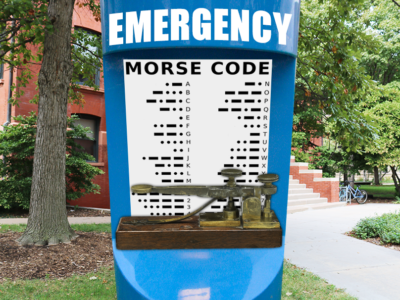
University of Nebraska-Lincoln students can breathe a sigh of relief when it comes to emergency response on campus. After the recent announcement of the UNL Police Department removing the emergency blue phones scattered around campus, plans are already set in motion to add an emergency telegram service in case of any student or faculty emergency.
Head of UNLPD Judd Jacobs spoke about the new service coming to campus in the near future. “I think this service is a great alternative to the blue phones,” said Jacobs. “The blue phones were a hassle to use in the first place. What we need is an easy-to-use service for students to create a safe environment on campus. That’s where we introduce the telegram.”
Jacobs went on to describe how the service would work. First, the student will send a message via Morse code from several electrical telegraph machines scattered across campus. The message will then be sent to a telegraph operations center on campus where a trained Morse code translator would transcribe the message. This message will then be delivered to UNLPD via mail, taking anywhere between one and three days to arrive at the UNLPD station. From here, officers will respond accordingly to the situation.
“I can say with confidence that I now feel safe walking around campus at night,” said junior marketing major Shirleen Chisom. “The blue phones were so hard to use. It always seemed like my calls were dropping. Now, my message can get sent straight to UNLPD. The University has taken a huge step forward today.”
“We are currently in the process of interviewing for our qualified Morse code operator position,” said UNL Chancellor Ronnie Green. “Right now, we are looking to hire 25 operators working around the clock to translate student emergency messages. This may be costly, but we want to do anything to keep our students safe.”
Chancellor Green went on to discuss plans for future emergency response options, such as a Pony Express system and a carrier pigeon system, both which will be directed by the Animal Sciences department.


